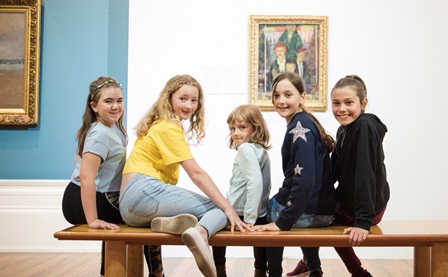Works on paper
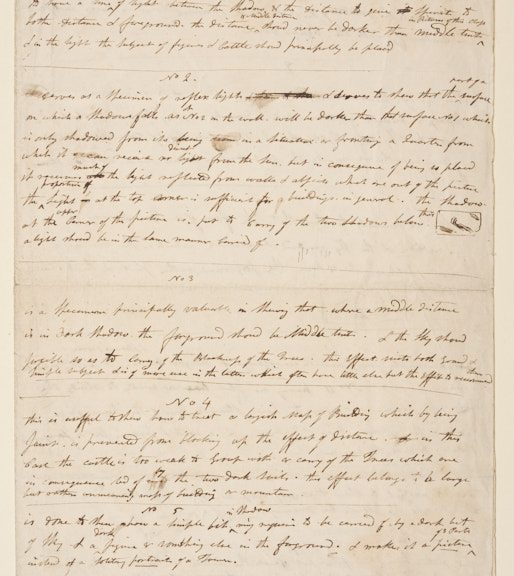
Manuscript of Instructions for Drawing
Date: about 1818
Object number: P1001.3
Artist: John Varley
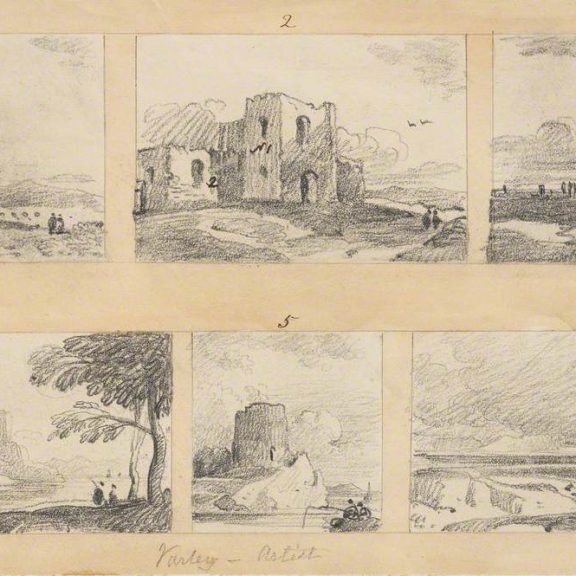
Sketches of Instructions for Drawing
Date: about 1818
Object number: P1001.2
Artist: John Varley
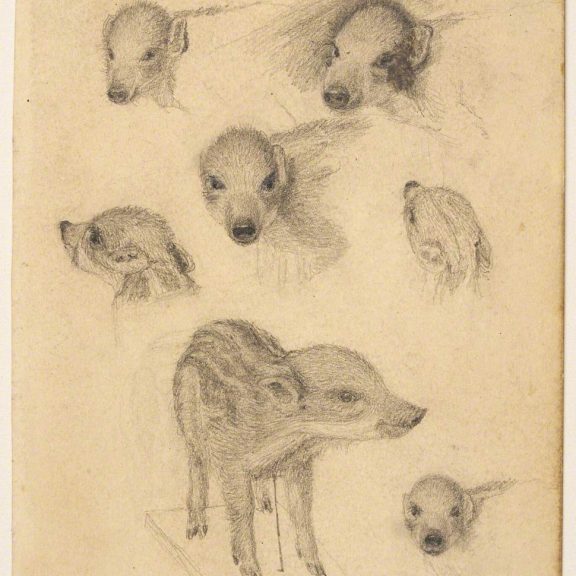
Iron Age Piglet
Date: about 1870
Object number: P1126.6
Artist: Joseph Wolf
Wolf was a German-born artist. He settled in England in 1848 and is described as the most successful natural history painter of his generation. He pursued his art according to the principle that ‘we see distinctly only what we know thoroughly,’ and paired exacting detail with a determination to capture the liveliness of his subjects.
He provided illustrations for many noteworthy organisations including the Zoological Society, skilfully bringing together the best attributes of science and art. Wolf was admired for treating his subjects as individual and distinct, rather than just examples of a species. A large number of his studies are held at the Victoria and Albert Museum in London.
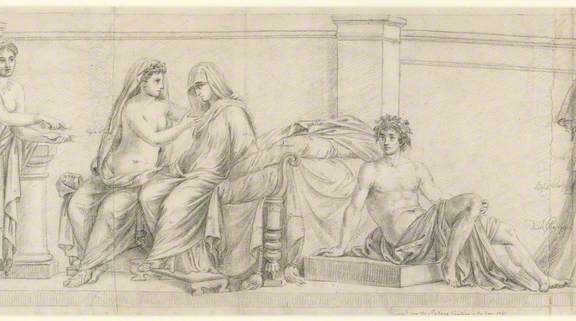
Study after the Aldobrandini Wedding
Date: 1763
Object number: P441
Artist: Joseph Nollekens
Nollekens went to Rome in 1762, where he studied and worked as an antique dealer and restorer, before returning to London in 1770.
This drawing is a study of an ancient fresco that was discovered in Rome in about 1600. There are a number of theories about the subject of the painting. One suggests that it represents the wedding of Peleus and Thetis, the parents of Achilles, the hero of the Trojan War.
Nollekens would have made this close study from the original fresco when it was still in the possession of the Aldobrandini family. It is now in the Vatican Museum’s collection.
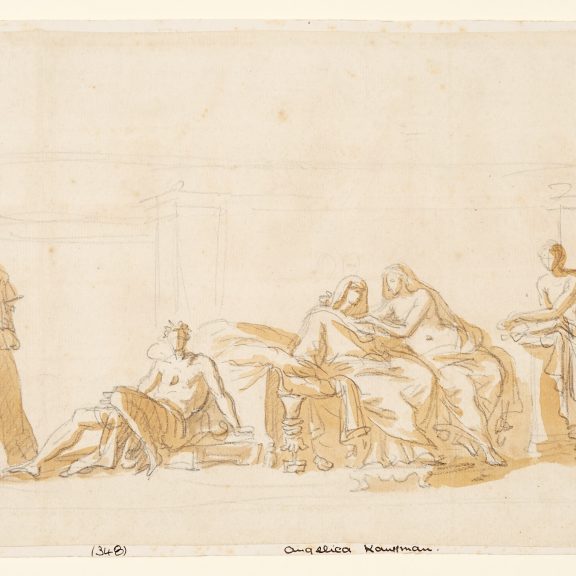
Study after the Aldobrandini Wedding
Date: about 1790
Object number: P348
Artist: Angelica Kauffman
As a woman, Kauffman was prohibited from drawing nude models. Instead she made studies of figures from paintings and sculpture. It is unclear when she saw the Aldobrandini Wedding, but this ancient Roman fresco, would have offered intriguing possibilities for studying drapery and the human form.
The drawing is made in reverse, indicating that Kauffman may have intended to make it into an engraving.
Kauffman was a Swiss-born painter who is best known for her portraits and historical subjects. She first visited Italy with her father in 1762, and returned to settle in Rome as an established artist some twenty years later. She was one of only two women invited to become Founding Members of the Royal Academy in 1768.
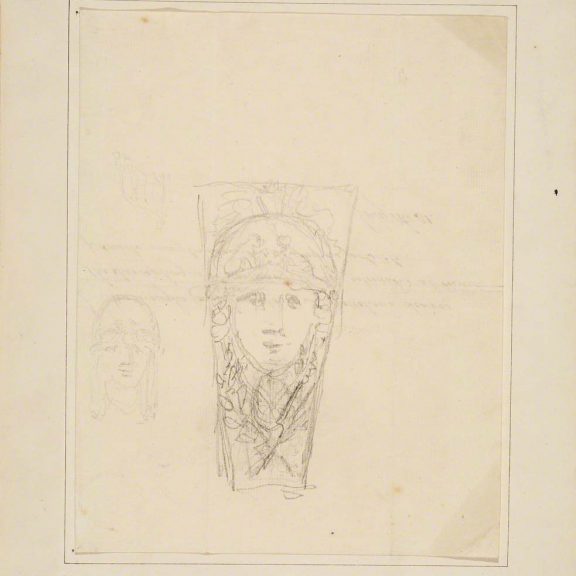
Sketch for a Keystone at Somerset House
Date: about 1795
Object number: P439
Artist: Joseph Nollekens
Nollekens designed some of the exterior decorative features for Somerset House in London. This drawing is an initial idea for the keystones that cap the arches near to what is now the entrance to The Courtauld Gallery. He made the sketch on the back of a letter relating to a commission for Lord Newborough.
The Courtauld Gallery moved to Somerset House in 1989. The building formerly housed the Royal Academy of Arts, where in 1772 Nollekens became a Royal Academician.
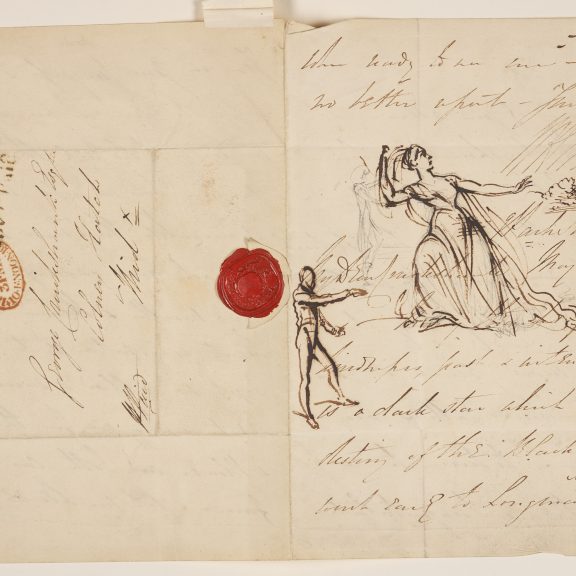
Sketches on a Letter
Date: about 1828
Object number: P1241.1
Artist: George Cruikshank
Nicknamed the ‘modern Hogarth’, Cruikshank was a popular Victorian caricaturist and book illustrator. This drawing is a collection of quick spur of the moment sketches made on the back of a letter dated 1828.
Cruikshank was best known for his satirical interpretations of modern life, often reflecting on the politics of the day. He was a good friend of Charles Dickens and illustrated several of his books, including Oliver Twist.
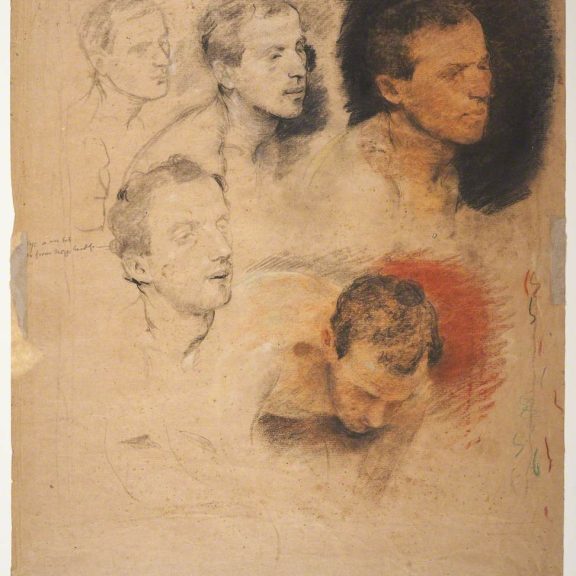
Study of a Male Head
Date: about 1890
Object number: P1584
Artist: William Edward Stott
This study captures a number of poses on a single sheet of paper. Stott was trying out different positions and experimenting with the effects of line, tone and colour. It could be an exercise in life drawing or an initial idea for a painting.
Stott was born in Rochdale, and was known by his middle name Edward to avoid confusion with the artist William Stott of Oldham.
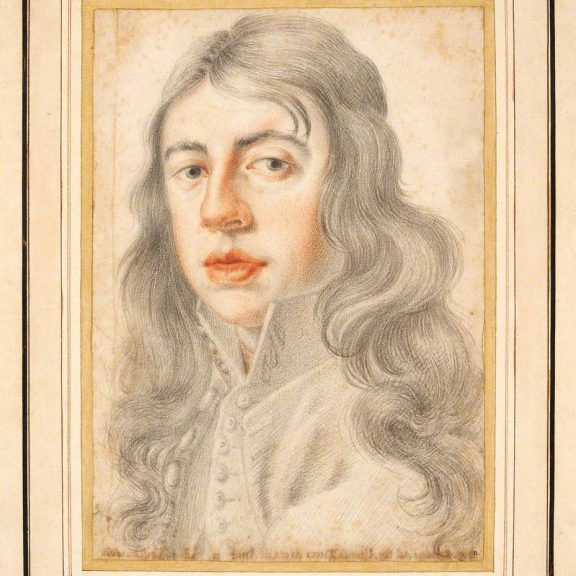
Presumed Portrait of Simone di Alfonso Tucci
Date: 1662
Object number: P743
Artist: Filippo Baldinucci
Baldinucci drew mostly portraits of his friends, all in roughly the same format. He combined delicate lines with subtle additions of red chalk to capture their likeness and showcase his draughtsmanship. This drawing, with its high degree of finish, was almost certainly intended as a presentation piece or a gift.
Baldinucci was an important artistic figure in 17th century Florence. He was employed as curator of the Medici family art collection, and published several books focussing on artists’ biographies.
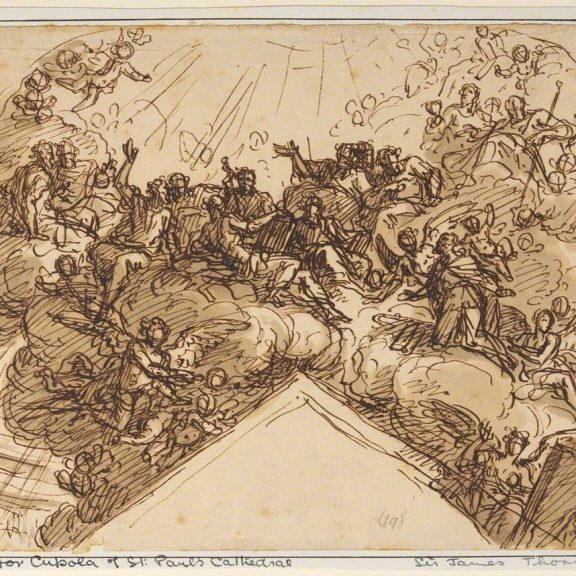
Design for the Cupola of St Paul’s Cathedral
Date: before 1715
Object number: P588
Artist: Sir James Thornhill
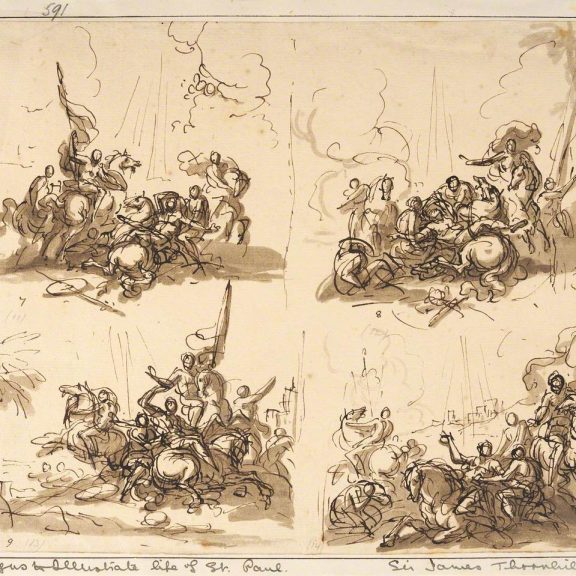
Four Designs Illustrating the Life of St Paul
Date: before 1715
Object number: P591
Artist: Sir James Thornhill
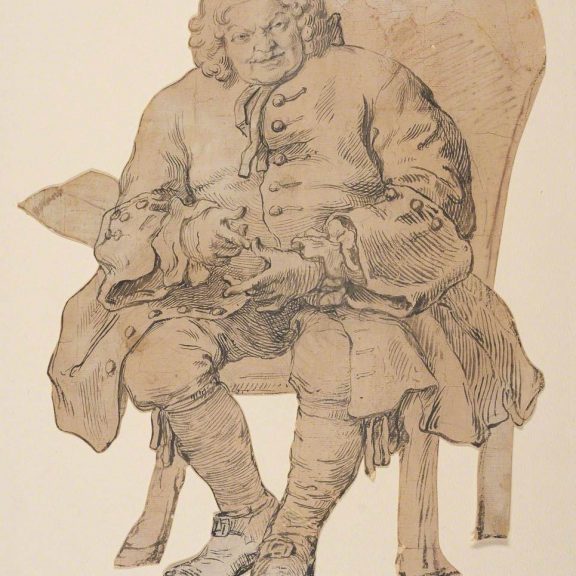
Simon Fraser, Lord Lovat
Date: 1746
Object number: P985
Artist: William Hogarth
Hogarth is best known for his satirical and moralising paintings and engravings. His observations of Georgian society were often witty and brutally honest. They were hugely popular and widely reproduced as prints.
Hogarth visited Lord Lovat when he was waiting to go on trial for high treason. This silhouetted drawing is most likely a preparatory sketch for the print on display to the right. The drawing was made in reverse. After etching and printing, the final image would appear as Hogarth intended.
Lord Lovat was known as ‘the most devious man in Scotland’ and nicknamed ‘the Fox’. Guided solely by self-interest, he switched his support back and forth during the Jacobite Risings. He was eventually found out in 1746 and executed the following year at Tower Hill for high treason.
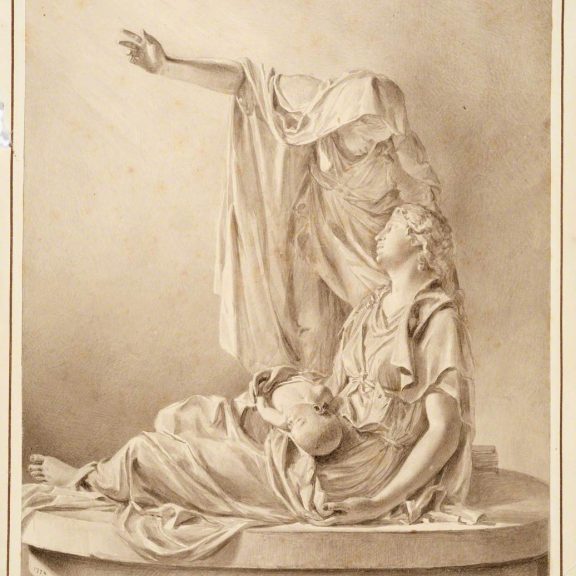
Monument of Mrs Howard
Date: about 1790
Object number: P442
Artist: Joseph Nollekens
Nollekens is one of Britain’s most celebrated sculptors. In the late 18th century his work was highly sought after by aristocratic patrons, who commissioned him to make portrait sculptures and memorials.
This is a drawing of what is considered to be his best work. Known as Faith, it is a memorial to Maria, who was the first wife of Henry Howard of Corby Castle, near Carlisle. They married in 1788. Maria died just a year later in childbirth, aged 23.
The memorial cost £1,500. It was installed near the castle, in Holy Trinity Church in 1803. The scene shows the dying mother with her dead infant daughter. She is supported by an angelic figure who represents her Christian faith.
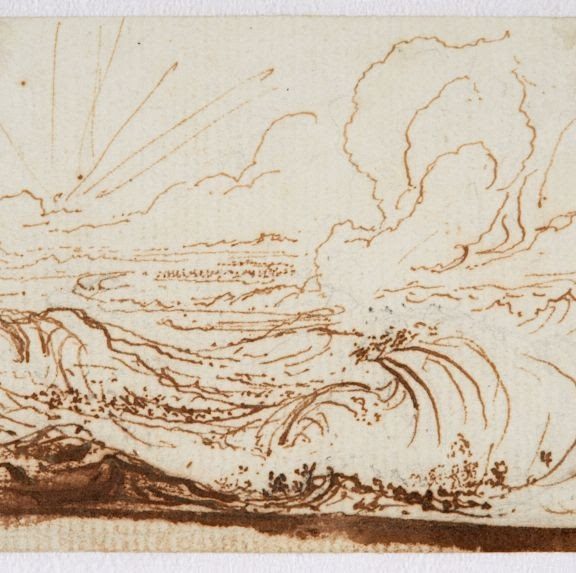
Destruction of the Pharaoh’s Host
Date: 1824
Object number: P745
Artist: John Martin
Martin is best known for his vast apocalyptic landscapes full of drama and spectacle. The subject depicted is the biblical story of Moses releasing the waters of the Red Sea, drowning the Egyptian army after allowing the fleeing Israelites to cross.
Despite the small scale of the drawing, the artist’s skilful penmanship brilliantly conveys the energy and epic scale of the unfolding drama.
The Harris has a painting that takes the same Bible story as its subject. You can see it on display at the top of the staircase in our virtual tour. It is by Francis Danby, who was a contemporary of Martin. Painted in 1825, The Delivery of Israel out of Egypt depicts Moses parting the Red Sea, allowing the Israelites to cross.
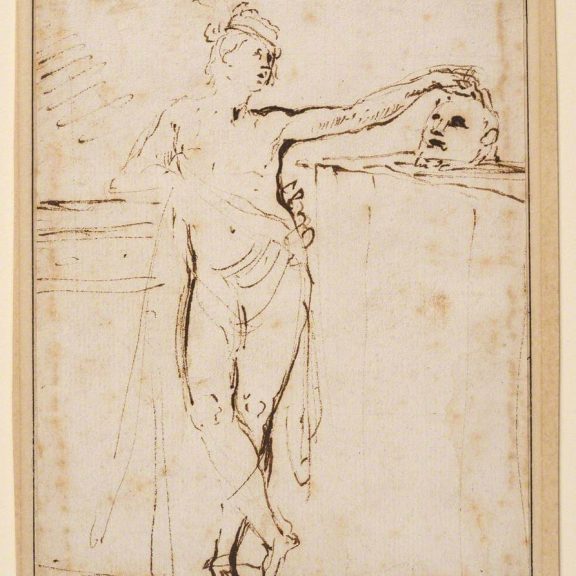
David With the Head of Goliath
Date: about 1620
Object number: P226
Artist: Guido Reni
Reni was a prominent artist of the Bolognese school in Italy, who later became one of the most important painters working in Rome.
This sketch illustrates a scene from the biblical story of David and Goliath. The young shepherd boy David stands next to the severed head of the giant Goliath, after killing him with a single shot from his slingshot.
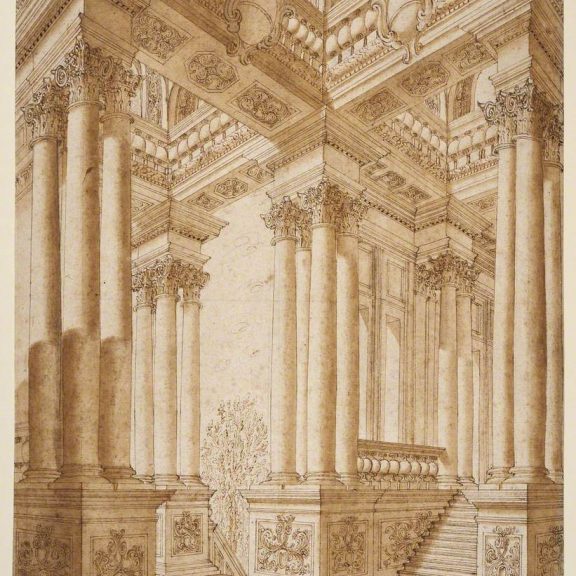
Architectural Fantasy
Date: about 1740
Object number: P984
Artist: School of Giuseppe Galli Bibiena
The Galli Bibiena family were Italian architects and scenic artists. They worked throughout Europe during the late 17th and 18th centuries creating elaborate sets for theatres and events hosted by wealthy patrons.
Because their work was mostly created as temporary decoration, little of it has survived. This complex and beautifully detailed drawing offers a rare glimpse into the splendour and richness of the imaginary worlds created by this family of artists and decorators.
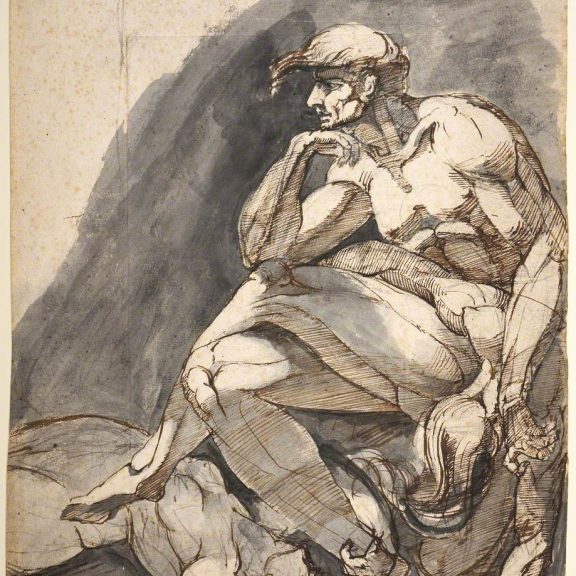
Man with Two Dead Women
Date: about 1772
Object number: P246
Artist: Henry Fuseli
Fuseli was a Swiss painter who lived and worked primarily in Britain. Many of his works deal with supernatural subjects and nightmares. His style influenced many younger artists, including William Blake, whose work is displayed on the right.
This drawing is of a particularly dark subject. It shows a seated man with the limp body of a dead woman draped across his knee. The emphasis on musculature and the unnatural position of the dead woman at his feet adds to the drama of the scene.
The dark wash in the background is a technique often used by Fuseli. It pushes the figures towards the viewer, adding to the sinister atmosphere of the work.
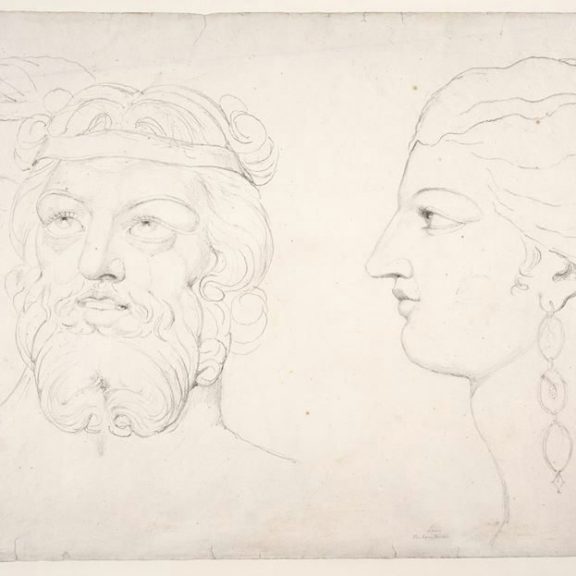
Visionary Heads
Date: 1820
Object number: P44
Artist: William Blake
Blake visited his friend John Varley, a landscape painter, over several nights in 1819. Here, from nine in the evening until the early hours, Blake is said to have sketched visions that appeared before him.
His drawings included long-dead historical figures such as Robert the Bruce and Alexander
the Great and characters of myth and legend including Merlin and Robin Hood. Blake continued to make these visionary drawings over a number of years. Most were gathered together in sketchbooks with inscriptions written by Varley.
The Visionary Heads in this drawing are Greek historical figures – Pindar the poet and Lais, a beautiful courtesan. The fine, delicate lines give the drawings a dream-like quality, the figures appear to hover on the page as if in a trance.
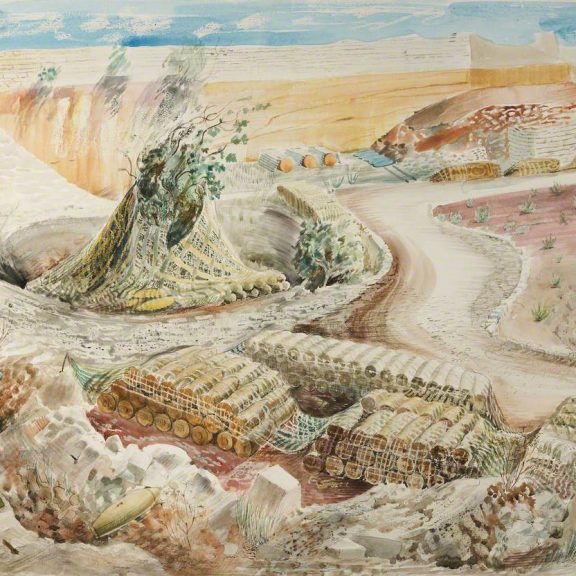
Malta, RAF Bomb Dump
Date: 1943
Object number: P1114
Artist: Leslie Cole
The Siege of Malta was a military campaign to maintain control of the island, which was an important British colony and trade route to North Africa, India, and the Far East.
Malta was one of the most heavily bombed places during the Second World War. The RAF and Royal Navy fought against German and Italian forces who attacked the island’s ports, towns and supply ships.
Cole arrived in Malta in May 1943. He observed the end of the siege, and recorded military sites like this bomb store. He also made paintings depicting the hardship and cruel conditions endured by Malta’s civilian population.
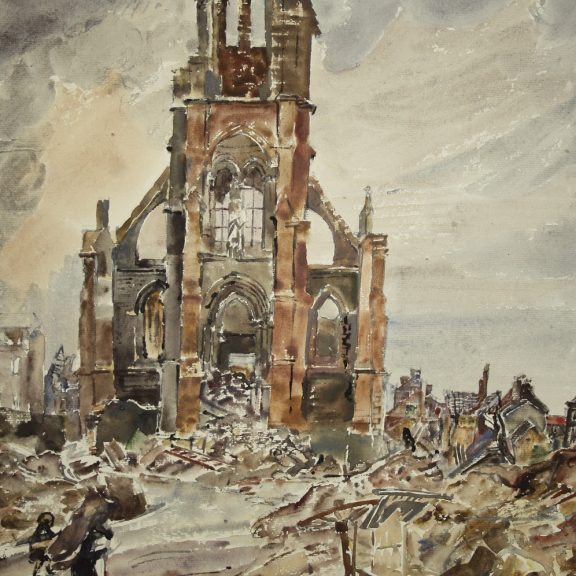
Church of St. Pierre, Boulogne
Date: 1944
Object number: P1112
Artist: Thomas Hennell
In June 1944, Hennell was sent to Portsmouth to record preparations for D-Day, the Allied invasion of Normandy. Soon after, he was across the English Channel making watercolour sketches of troops on the Normandy beaches.
The coastal town of Boulogne was badly bombed by the RAF during the invasion. In August, Hitler declared the town a “fortress”, but in September the town was liberated by the Canadian Army. This painting of the town’s church in ruins is a poignant reminder of the suffering and destruction endured by so many during the Second World War.
Hennell was sent to record the war effort in India and Burma (now Myanmar). He survived the war but disappeared in Java in 1945. Reports suggest that he was captured and killed during the Indonesian War of Independence, but this was never confirmed.
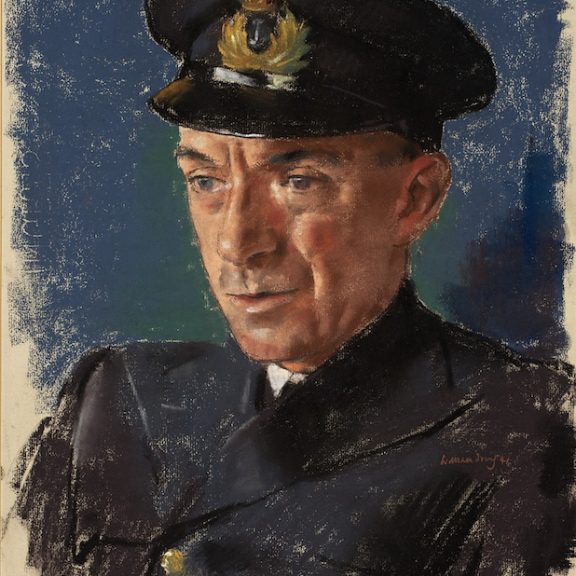
Lieutenant (E) R W Daish RNR Chief Engineer
Date: 1941
Object number: P1110
Artist: William Dring
This is a portrait of Ralph William Daish, the Chief Engineer of HMS Lorna Doone. A paddle steamer requisitioned by the Admiralty as a minesweeper in 1939. The Admiralty was the government department responsible for the command of the Royal Navy.
Dring was born in Streatham, London. He graduated at the Slade School of Art, before teaching drawing at Southampton School of Art. Dring was appointed as an official War Artist to the Admiralty in 1942.
He travelled widely across Britain, making portraits of Naval officers. Working in soft pastel allowed Dring to get colour and detail onto the paper quickly. He took no longer than an hour to finish each portrait.
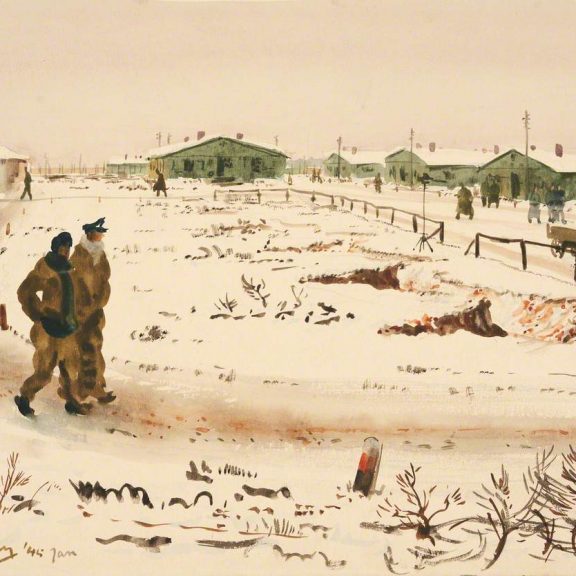
Marlag ‘O’ in Winter
Date: 1945
Object number: P1353
Artist: John Worsley
At the start of the Second World War, Worsley joined the Royal Navy. His drawings of life at sea caught the attention of the War Artists’ Advisory Committee, and he was appointed as a full-time war artist.
In 1943 Worsley was captured by the Germans and detained at Marlag ‘O’, a prisoner-of-war camp. He continued to paint at the camp, documenting prison life using materials provided by the Red Cross. These parcels contained food and other supplies, reminding the men that they had not been forgotten. The tin cans were re-used for a variety of purposes, in Worsley’s case to safely carry his pictures to freedom in April 1945.
His skills as an artist were employed to forge identity papers. He also made a life-sized mannequin called Albert during an ingenious escape attempt, which in 1953 was made into a film, Albert R.N.
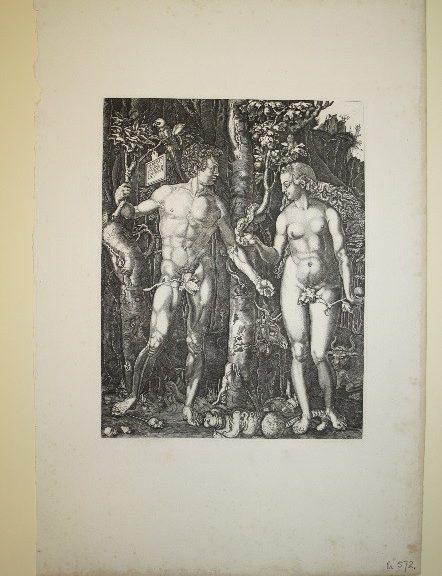
Adam and Eve (the fall of Man)
Date: Unknown
Object number: PR275
Artist: Albrecht Durer Engraver. Johannes Ladenspelder
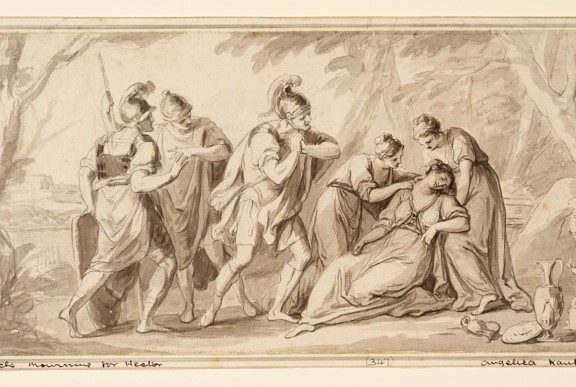
Andromache Fainting at the Unexpected Sight of Aeneas on his Arrival at Epirus
Date: 1775
Object number: P347
Artist: Angelica Kauffmann, 1741-1807
This drawing by Angelica Kauffman is a study for a painting commissioned by the Earl of Derby for his London home in 1775. Based on a story in the Aeneid, an epic poem written by Virgil between 29 and 19BC about the Trojan Wars, the scene depicts Andromache who has been invoking the spirit of her husband Hector. Aeneas, who she believes might be a messenger from the dead, appears and confirms that Hector has been killed and Andromache collapses in grief.
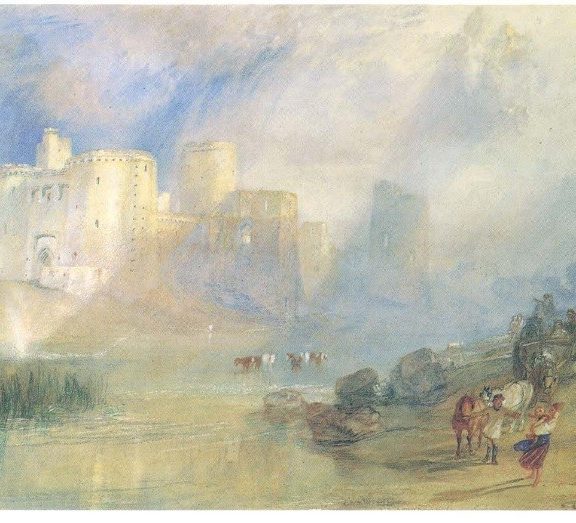
Kidwelly Castle, South Wales
Date: 1835
Artist: JMW Turner, 1775-1851
The Harris’ collection of watercolours includes paintings by JMW Turner, David Cox, Arthur Rackham, Helen Allingham, and Laura Knight.
Kidwelly Castle has occupied its commanding position above the River Gwendreath in South Wales since the 12th century. Turner visited Kidwelly during his 1795 tour of Wales and returned to the subject in 1835 for a series of Picturesque Views in England and Wales. In this atmospheric painting the gatehouse glows in bright sunlight while the rest of the castle emerges from a swirling river mist.
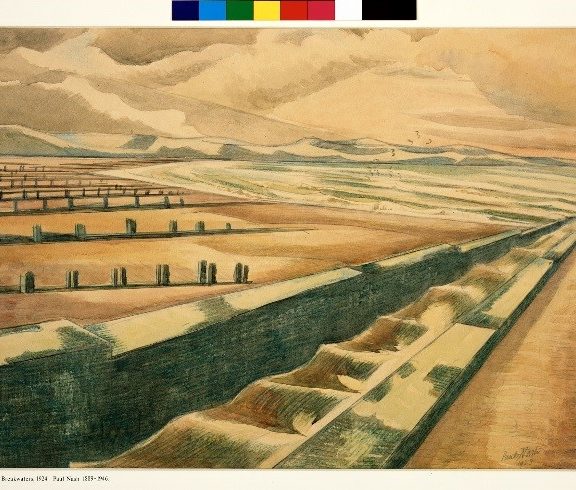
Channel and Breakwater
Date: 1923
Artist: Paul Nash
The Harris has a small but notable collection of Modern British art, including paintings by Walter Sickert, Stanley Spencer, Matthew Smith, Ivon Hitchens, David Bomberg, and Lucian Freud.
After serving in the First World War, Nash suffered a breakdown and was diagnosed with ‘war strain’. To recuperate, he and his wife rented a cottage at Dymchurch on the Kent coast.
His experiences during the war led him to consider the coast line as a conflict between the sea and land. The geometric lines reflect Nash’s early experiments with abstraction, and suggest a coordinated battle between the sea and the man-made defenses built to protect the land from invasion.
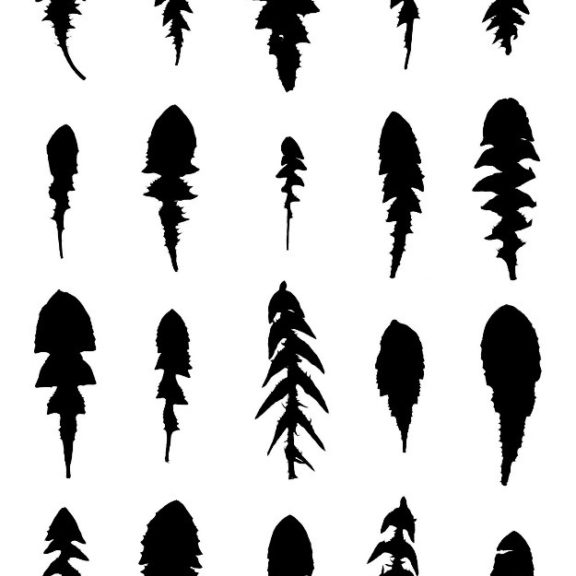
Dandelions
Date: 2012
Object number: 2018.17.1
Artist: Rebecca Chesney
In 2018 Rebecca was invited to spend time in the Harris Museum archive to discover any objects in the collection connected to the theme of dandelions. The exhibition comprised objects from the artist’s Dandelion Archive and items from the Harris collection they were placed in sixteen different locations within the museum’s displays and galleries for visitors to find.
Although seen by many as a weed, dandelions are a symbol of hope in folklore, and have fond associations with traditions like making wishes and telling the time.
The Dandelion Archive is an ongoing project where the artist explores the dandelion’s symbolism, and how it is represented in cultural collections of prints, textiles and ceramics.
